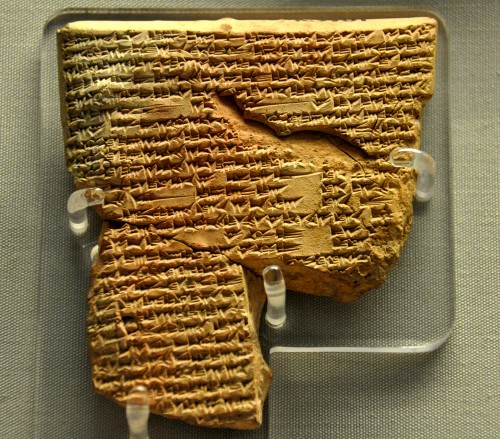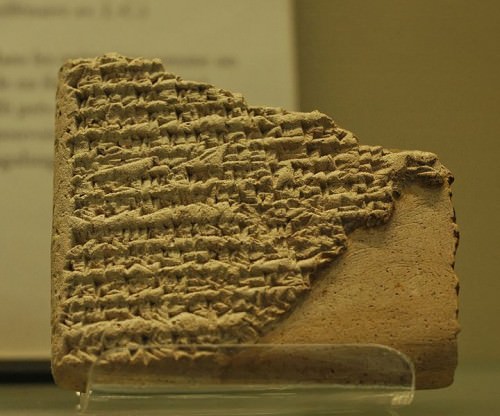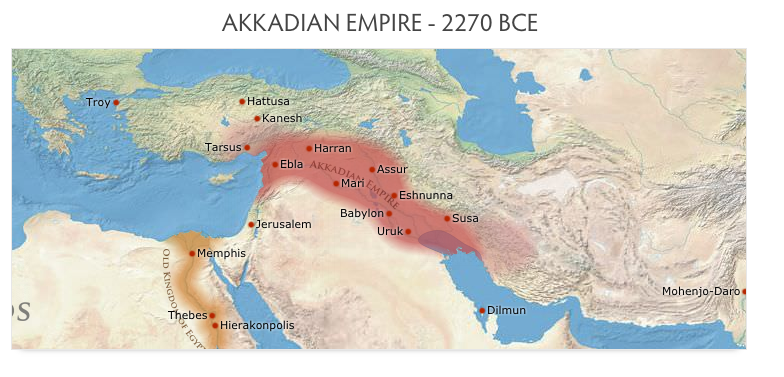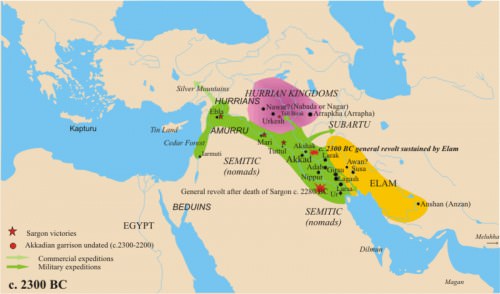Reading: Sargon of Akkad

Sargon of Akkad (also known as Sargon the Great, Shar-Gani-Sharri, and Sarru-Kan, meaning "True King" or "Legitimate King") reigned in Mesopotamia from 2334 to 2279 BCE. He is equally famous today as the father of the great poet-priestess Enheduanna. He was born an illegitimate son of a "changeling", which could refer to a temple priestess of the goddess Innana (whose clergy were androgynous) and, according to the Sargon Legend (a cuneiform clay tablet purporting to be his biography) never knew his father. His mother could not reveal her pregnancy or keep the child, and so he was set adrift by her in a basket on the Euphrates River where he was later found by a man named Akki who was a gardener for Ur-Zababa, the King of the Sumerian city of Kish. From this very humble beginning, Sargon would rise to conquer all Mesopotamia and create the first multi-national empire in history.
The Akkadian Empire was the first political entity to make extensive and efficient use of bureaucracy and administration on a large scale and set the standard for future rulers and kingdoms. His story was long known throughout Mesopotamia where, in time, he came to be considered the greatest man who had ever lived, celebrated in glorious tales down through the Persian Empire, along with his grand-son Naram-Sin. The historian Paul Kriwaczek sums up the impact Sargon had on later generations in Mesopotamia,writing, "for at least 1,500 years after his death, Sargon the Great, founder of the Akkadian Empire, was regarded as a semi-sacred figure, the patron saint of all subsequent empires in the Mesopotamian realm" (111). Even so, where he came from and even his actual name are unknown.
EARLY LIFE & RISE TO POWER
`Sargon' was not the name given him at birth but the throne name he chose for himself. It is a Semitic, not Sumerian, name and so it is generally accepted that he was a Semite. Nothing certain is known of Sargon's birth or younger years. In fact, although his name was among the most famous in antiquity, he was unknown to the modern world until 1870 CE when the archaeologist Sir Henry Rawlinson published the Legend of Sargon which he had found in the library of Ashurbanipal while excavating Nineveh in 1867 CE. The Legend of Sargon reads:
My mother was a changeling, my father I knew not,
The brother of my father loved the hills,
My home was in the highlands, where the herbs grow.
My mother conceived me in secret, she gave birth to me in concealment.
She set me in a basket of rushes,
She sealed the lid with tar.
She cast me into the river, but it did not rise over me,
The water carried me to Akki, the drawer of water.
He lifted me out as he dipped his jar into the river,
He took me as his son, he raised me,
He made me his gardener (Bauer, 95).
Akki adopted the boy and raised him as his own son. Sargon rose in stature at court to become the king's cup bearer. The historian Susan Wise Bauer notes that, "ancient cupbearers were not merely butlers. The Sumerian inscriptions do not describe the cupbearer's duties, but in Assyria, not too long afterwards, the cupbearer was second only to the king" (97). In his capacity as cupbearer, Sargon had the king's trust but this was put to the test when a neighboring king, Lugalzagesi or Umma, embarked on a military campaign of conquest in the region. Ancient Mesopotamia (like ancient Greece) was dotted with many small city-states all of whom fought one another over fertile territory and water.
Lugalzagesi of Umma marched his army through the region of Sumer and conquered the city-states one by one, uniting all of them under his authority. He would be the first Sumerian king to accomplish this to any great extent; and the last Sumerian king before the rise of Akkad. He seems to have earlier agreed to leave Kish alone but, after conquering Uruk, he decided to move on Kish. Bauer writes how, "Ur-Zababa, learning that the army of the conqueror was approaching his city, grew so frightened that he `sprinkled his legs'"(97). He had grown suspicious of Sargon and, although there seems to be no evidence that the cupbearer had given him cause, decided to send him to Lugalzagesi ostensibly with an offer for peace. Whether Ur-Zababa actually included in the message anything about terms and conditions is not known; what is known is that message asked Lugalzagesi to kill Sargon upon receiving it. For whatever reason, Lugalzagesi refused to comply and instead invited Sargon to join him. Together, they marched on Kish and took the city easily. Ur-Zababa escaped and went into hiding.
Precisely what happened next is unclear owing to the many legends which grew up around Sargon's life and reign over the centuries. It is possible that he had an affair with Lugalzagesi's wife at this point or that he was sent on a mission which he turned into the first engagement of his own conquest of the region. Whatever happened between him and Lugalzagesi, they were as quickly antagonists as they had been allies. Sargon marched on Uruk and took it. Lugalzagesi marched his army from Kish to meet Sargon in battle and was defeated. Sargon then put him in chains, tied a rope around his neck, and took him to the city of Nippur, sacred to the god Enlil upon whom Lugalzagesi had relied, and forced him to march in humiliation through the Enlil's gate. Sargon chose for himself the goddess Ishtar (Inanna) for his divine protector and, with both Ur-Zababa and Lugalzagesi out of the way, proclaimed himself king of Kish and swiftly subdued the region of Sumer.
MILITARY CAMPAIGNS & EMPIRE BUILDING
When Sargon overthrew Lugalzagesi and seized power he gained an already united kingdom which he could use to advantage in military campaigns to establish the first empire over all of Mesopotamia. He may have been helped in this by his own legend which established his humble backgrounds. As in later ages and other cultures, up to the present day, class distinctions in the Sumerian cities had led to a growing resentment by the lower class for the upper elite. The wealthiest citizens were able to take as much land as they could hold and the lower classes routinely felt disenfranchised. Sargon's tale of his humble beginnings as a gardener would have appealed to the large numbers of working-class Sumerians who may have seen him as a liberator and reformer. Directly after his rise to power, however, the city-states and their ruling elite hardly accepted Sargon with grace and submission; they rebelled against their new ruler, and forced him to prove his legitimacy as king through military might.
After conquering Sumer, he either built a new city or renovated an older one, Akkad (also known as Agade) on the banks of the Euphrates River. This was a complete break with precedent in that, previously, the king of an existing city conquered another for the glory of the home city and the resources which would now be available. Sargon, on the other hand, conquered for no city, only for himself and, once he had control of the area, then built his own city to enjoy the benefits of conquest. Not content with what he had accomplished thus far, he set out again on campaign. Bauer writes:
With the Mesopotamian plain under his control, Sargon set out to build an empire that stretched beyond Mesopotamia. He led these soldiers in campaign after campaign: `Sargon, the king of Kish,' reads one of his tablets, `triumphed in thirty-four battles.' He crossed the Tigris and seized land from the Elamites. He fought his way north to the city of Mari, which he captured, and then pushed even further into the land of another Semitic tribe, wilder and more nomadic than his own Akkadians: the Amorites, who ranged across the land west of the Caspian Sea. Campaigning up the Tigris, he reached and conquered the little northern city of Ashur... After this, he ranged even farther north and asserted his rule over the equally small city of Nineveh...Sargon may even have invaded Asia Minor (101).
He may also have taken Cyprus and claims to have marched to the Mediterranean Sea and sent ships as far away as India for trade. He marched throughout Mesopotamia conquering one city-state after another and expanded his empire as far as Lebanon and the Taurus mountains of Turkey and then went even further. He instituted military practices of combining different types of fighting forces in looser formations (to enable greater mobility and adaptability on the field) which became standard down through the time of Alexander the Great. He swept across the land with his army until he had formed the formed the first empire in the world. Kriwaczek writes:
There had been Mesopotamian heroes before of course. The famous kings of early Uruk, like Gilgamesh and his father Lugalbanda, were the protagonists of a series of fantastical accounts and tales of outlandish deeds that became mainstays of the Sumerian literary canon and were copied and recopied inscribal schools and palace scriptoria for centuries, sometimes millennia. But they belong to the age ofmythology rather than heroic legend; they told of intimate intercourse with the gods, battles with fearful monsters, the search for immortality and extraordinary other-worldly adventures. With the advent of Sargon, his sons and grandsons, the tales become, not necessarily more believable, but at least centred on the here-and-now of earthly life (Bauer, 113).
 INSCRIPTION OF THE BIRTH OF KING SARGON OF AKKAD
INSCRIPTION OF THE BIRTH OF KING SARGON OF AKKAD
THE AKKADIAN EMPIRE
Forming an empire is one thing; but keeping it operating is quite another. Still, in administration, Sargon proved himself as capable as he was in military conquest. In order to maintain his presence throughout his empire, Sargon strategically placed his best and most trusted men in positions of power in the various cities. The "Citizens of Akkad", as a later Babylonian text calls them, were the governors and administrators in over 65 different cities. One of his inscriptions reads, "From the sea above to the sea below, the sons of Akkad held the chiefdoms of his cities" and Bauer notes how, "In this kingdom, the Sumerians rapidly found themselves living as foreigners in their own cities...When Sargon took over a city, it became an Akkadian stronghold, staffed with Akkadian officials and garrisoned with Akkadian troops" (99). Sargon also cleverly placed his daughter, Enheduanna, as High Priestess of Inanna at Ur and, through her, seems to have able to manipulate religious, political, and cultural affairs from afar. Enheduanna is recognized today as the world's first writer known by name and, from what is known of her life, she seems to have been a very able and powerful administrator in addition to her literary talents.
The stability provided by this empire gave rise to the construction of roads, improved irrigation, a wider sphere of influence in trade, as well as developments in arts and sciences. The Akkadian Empire created the first postal system where clay tablets inscribed in cuneiform Akkadian script were wrapped in outer clay envelopes marked with the name and address of the recipient and the seal of the sender. These letters could not be opened except by the person they were intended for because there was no way to open the clay envelope save by breaking it, thus ensuring privacy in correspondence. Sargon also standardized weights and measures for use in trade and daily commerce, initiated a system of taxation which was fair to all social classes, and engaged in numerous building projects such as the restoration of Babylon (which, according to some sources, he founded - though this is not generally accepted as true). He also created, trained, and equipped a full-time army - at least in the city of Akkad - where, as an inscription reads, 5400 soldiers "ate bread daily" with the king. While this does not seem to be the kind of professional army later created by the Assyrian king Tilgath Pileser III, (as it seems it was neither year-round nor kept in a near-constant state of mobilization) it was a great advance over the armies of the past.
Even with these improvements to the lives of the citizens of Mesopotamia, the people still rebelled against Akkadian rule. Throughout his life Sargon would continue to encounter uprisings as city-states asserted their autonomy and rose against the empire. As the centuries passed, however, whatever difficulties they had with Sargon's rule were forgotten and all that was remembered were his heroic feats and the `golden age' of the Akkadians. For the next 3,000 years the Babylonians would tell tales of the kings who rose against Sargon of Akkad and of his glorious victories, citing Sargon's own words from his purported autobiography,
In my old age of 55, all the lands revolted against me, and they besieged me in Agade but the old lion still had teeth and claws, I went forth to battle and defeated them: I knocked them over and destroyed their vast army. Now, any king who wants to call himself my equal, wherever I went, let him go!
According to the Sumerian king list, Sargon reigned for 56 years and died in old age of natural causes. If he had seemed larger than life to his people during his reign, he assumed an almost god-like status in death. Kriwaczek writes:
Up until now, civilization based itself upon the belief that humanity was created by gods for their own purposes. The cities, the repositories of civilization, were divine foundations, having started, we guess, as sacred pilgrimage centres. Each city was the creation and home of a particular god. It is as if `real life' was the one lived by the gods in the divine realm while what went on down here on earth was a largely irrelevant sideshow. The age of Sargon and Naram-Sin altered all that, switched the focus to the human world, and introduced a new conception of the meaning of the universe: one that made people rather than gods the principal subjects of the Mesopotamian story. Humanity was now in control. Men - and women - became rulers of their own destiny. To be sure, people were still pious, still presented sacrifices to the temples, offered the libations, performed the rites, invoked the gods' names at every opportunity. But the piety of the age now had a quite different flavour (119).
 BIRTH OF SARGON OF AKKAD
BIRTH OF SARGON OF AKKAD
LEGEND & LEGACY
The legends which grew up around Sargon and his dynasty were still being written, copied, and performed in the last days of the Assyrian Empire (612 BCE) and the famous copper head of Sargon (found at Nineveh in 1931 CE, making clear his importance to the Assyrians) is one of the most instantly recognizable works of Mesopotamian art. The story of the baby set forth in a basket on the river, who is found by nobility and grows up to be a great leader of his people, was used to great effect by the Hebrew scribe who borrowed it to write the biblical Book of Exodus and the story of the hero Moses. Sargon's story is the tale of the hero who rises from obscure beginnings to save his people. Whether he was seen as this kind of savior by those who lived under his reign is doubtful considering the number of rebellions he had to put down but to those who came after him, those who lived under the occupation of the Gutians (described by scholar Samuel Noah Kramer as demoralizing, destructive, and "a ruthless, barbaric hoarde"), he and his dynasty represented the glorious age of hero-kings which was now gone. The tales of Sargon are thought to have inspired the Sumerians to rise up and throw off the oppressive Gutian rule in c. 2046 BCE. Under the Sumerian kings Utu-Hegel and Ur-Nammu, the Gutians were driven from Sumer which allowed for the flourishing of the so-called Sumerian Renaissance (2047-1750 BCE). The great Sumerian kings of the Ur III Period, Ur-Nammu (reigned 2047-2030 BCE) and Shulgi of Ur (reigned 2029-1982 BCE) both patterned their public images after those of Sargon and Naram-Sin.
After Sargon's death, the empire passed to his son Rimush, who was forced to endure what his father had and put down the rebellions which contested his legitimacy. Rimush reigned for nine years and, when he died, the kingship passed to Sargon's other son, Manishtusu who ruled for the next fifteen years. Though both sons ruled well, the height of the Akkadian Empire was realized under Sargon's grandson, Naram-Sin. During his reign, the empire grew and flourished beyond the boundaries even Sargon had attained. After his death, his son Shar-Kali-Sharri became ruler and, at this time, the empire began to unravel as city-states broke away to form their own independent kingdoms.
Shar-Kali-Sarri waged almost continual war against the Elamites, the Amorites and the invading Gutians while trying to hold the empire together but, finally, it fell apart. The Gutian Invasion has been most commonly credited with the collapse of the Akkadian Empire and the Mesopotamian dark age which ensued and this was certainly the view of later Mesopotamian writers who portrayed the Gutians as destroyers of civilization. Recent studies, however, suggest that it was most likely climate change which caused a famine and, perhaps, disruption in trade, weakening the empire to the point where the type of invasions and rebellions which were easily met and put down in the past could no longer be managed as effectively. Famine is alluded to in a later work known as The Curse of Agade (written c. 2047-1750 BCE) which tells of the destruction of Akkad by the will of the gods. Whether famine, invasion, the wrath of the gods, or all three, the city of Akkad fell, the great kings were gone, and the empire passed into the legends which would be told, re-told, written, and copied until the stories of what once was became all that was left of the Akkadian Empire of Sargon the Great.
Map


